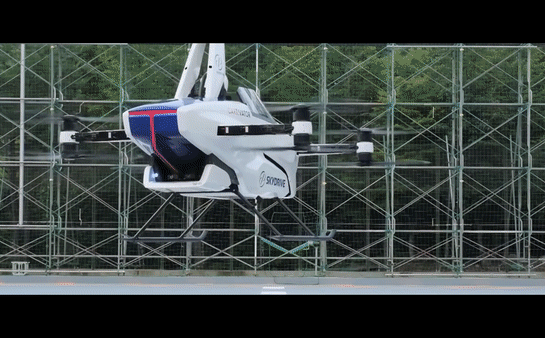Humans have come closer to ‘flying cars’
- Tram Ho
In the 1880s, the first automobile was developed and about two decades later, the Wright brothers in North Carolina invented the first successful aircraft. Today, the world is getting closer to merging those two concepts into one, when a Japanese tech company says it has completed a manned test flight of a “flying car”.
SkyDrive said last weekend it completed a test flight with “the world’s first manned test device”, code-named SD-03. It is a vehicle with vertical takeoff and landing (eVTOL) capabilities. The company says the flight time is 4 minutes.

The aircraft has a single seat and operates with eight engines and two propellers in each corner. The device was lifted off the ground at a height of 3 meters and was operated by a pilot.
Tomohiro Fukuzawa, CEO of SkyDrive, said five years ago appeared many different flying car prototypes, but usually with fixed wings. And SkyDrive products are one of the prototypes that are compact and lighter in size than other designs.
SkyDrive flying car prototype
SkyDrive was opened in 2012 by members of a volunteer organization called Cartivator. The company has been developing “flying cars” since 2014, according to the official website. This year, SkyDrive received funding from the Japan Development Bank and other investors, company representatives said.
There are a number of companies developing similar technology, including Boeing and Airbus, as well as carmakers Toyota and Porsche. In January, Hyundai and Uber announced they were working on an electric taxi.
According to Morgan Stanley analysts, they expect urban air taxis to be popular by 2040, with the global market forecast to be $ 1,400 billion to $ 2,900 billion at that time.
Safety is one of the two major challenges preventing the technology from being widely used, said Derya Aksaray, assistant professor of aerospace and mechanical engineering at the University of Minnesota.
“These vehicles need to consider their environment, assess the situation and take appropriate action,” said Ms. Aksaray. “They can’t wait for an order by a pilot or an operator. We can’t wait for this kind of micro-management on this kind of vehicle.”
In addition to safety, the remaining challenge is design. Vehicles should be strong enough to carry any weight needed, but quiet enough to fly at low altitudes.
Ella Atkins, professor of aerospace engineering at the University of Michigan, also expressed mixed views about the practicality of eVTOL.
“They will be more energy efficient than helicopters but will be less energy efficient than cars because they have to lift themselves,” she said. “From a cost perspective, it wouldn’t be practical to go to the grocery store.”
Professor Atkins said the machines could be more suitable for satellite regions of cities or countries with complex terrain.
“These vehicles can provide transportation services , “ added Professor Atkins. “These areas could bypass both road construction and use aircraft as their primary form of transportation.”

According to Mr. Fukuzawa – CEO of SkyDrive – the company plans to start selling versions of eVTOL two seats by 2023 for about 300,000 to 500,000 USD. He predicts prices will fall by 2030.
“With any new technology, it will be very expensive at first,” agreed Professor Aksaray.
She also said that it is unlikely that people with modest income will be able to afford a cost of this equipment within the next 20 years.
“We’re at the entry stage,” she said. “We don’t have mass production, there will be a need to reduce the costs of all small-scale development, research, deployment and production.”
However, according to Professor Aksaray, the human race is on the brink of a new moving revolution, reminiscent of the revolutions created from the invention of cars and planes before.
“If this works,” she said. “I think that will definitely create another means of transportation. We will benefit greatly by reducing congestion and overcoming the geographic constraints of traveling on the ground.”
Refer to NYTimes
Source : Genk
